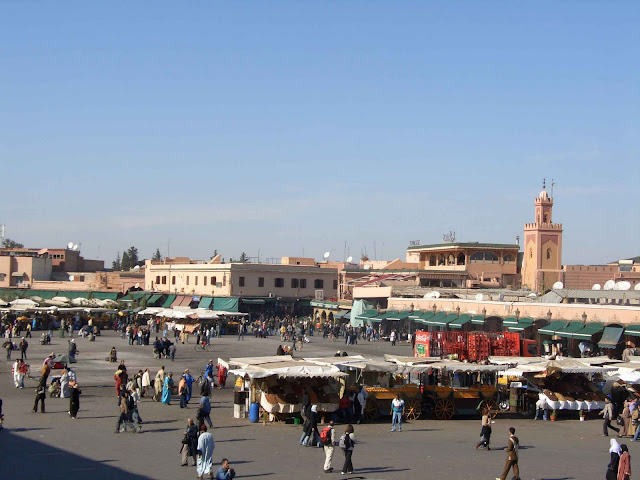Djemaa el Fna
Next to the Koutoubia lies the great square of Jamaa el Fna This famous market place is located in the heart of the medina. It is that very pulsating heart. Where does that name "Djemma El Fna" come from? The origin of its name remains unknown: it means Assembly of the dead in Arabic (جامع الفناء jâmiʻ al-fanâʼ) , but as the word Jemaa also means mosque in Arabic, it could also mean Place of the Vanished Mosque, in reference to a destroyed Almoravid mosque, or it could mean The Mosque of Eternity or The Mosque of Annihilation or perhaps The Mosque at the End of the World.[1] See the Wikipedia ArticleThe square
The place remains the main square of Marrakesh, used equally by locals and tourists. During the day it is predominantly occupied by orange juice stalls, youths with chained Barbary apes, water sellers in colourful costumes with traditional leather water-bags and brass cups, and snake charmers who will pose for photographs for tourists.[2] As the day progresses the entertainments on offer change: the snake charmers depart, and in the afternoon and evening the square becomes more crowded, with Chleuh dancing-boys (it would be against custom for girls to provide such an entertainment), story-tellers (telling their tales in Berber or Arabic, to an audience of appreciative locals), magicians, and peddlers of traditional medicines. As dark descends the square fills with dozens of food-stalls, and the crowds are at their height.The square is edged along one side by the Marrakesh souk, the traditional North African markets which service both the common daily needs of the people of the city, and the tourist trade. On other sides are cafe terraces to escape from the noise and confusion down in the square, and on yet other sides are hotels and gardens. Narrow streets lead into the alleys of the medina quarter, the old city. The photograph illustrating this article shows the entrance to the souk at the left, cafes in the centre, and the entrance to the medina via the Street of the Olive (derb al zitoun) on the right
.
Once a bus station, the place was closed to vehicle traffic in the early 2000s. The authorities are well aware of its importance to the tourist trade, and a strong but discreet police presence ensures the safety of visitors.
True what the Wikipedia says about the police. One of the major changes I have seen all over Morocco (especially in Fes) is the absence of faux guides or touts that used to meet you on the street to try to lure you to visit a carpet seller and get a commission if there is a sale. They were so notorious at the time (1980s) that during our Peace Corps stage in Larache, we actually got training on how to get rid of them and learned strategies to keep them at bay. Firstly, we avoided wearing shorts in the Medina: only tourists wore shorts. Secondly, we all learned how to get rid of the real pesky ones by saying that funny expression "Sir ferhalik" which means "Go to your pleasure" which was much nicer thing to say than "Go to h**l," Actually, at the end of my stay, I was surprised to feel a little sad they disappeared; they used to be such an integral part of the whole medina scene!
Masterpiece of the Oral and Intangible Heritage of Humanity
The idea for the UNESCO project Masterpieces of the Oral and Intangible Heritage of Humanity came from people concerned about the Jamaa el Fna. The locality is known for its active concentration of traditional activities by storytellers, musicians and performers, but it was threatened by economic development pressures. In fighting for the protection of traditions, the residents called for action on an international level to recognize the need for the protection of such places — termed "cultural spaces" — and other popular and traditional forms of cultural expression.[3] UNESCO encourages communities to identify, document, protect, promote and revitalize such heritage. The UNESCO label of Masterpieces of the Oral and Intangible Heritage of Humanity aims to raise awareness about the importance of oral and intangible heritage as an essential component of cultural diversity.| “ | The spectacle of Jamaa el Fna is repeated daily and each day it is different. Everything changes – voices, sounds, gestures, the public which sees, listens, smells, tastes, touches. The oral tradition is framed by one much vaster – that we can call intangible. The Square, as a physical space, shelters a rich oral and intangible tradition. | ” |
—Juan Goytisolo, in a speech delivered at the opening meeting for the First Proclamation, 15 May 2001[4 | ||
Trivia from Wikipedia:
- The square was featured in the Alfred Hitchcock movie The Man Who Knew Too Much (1956).
- An interesting account of the place in the 1970s can be seen in Esther Freud's novel Hideous Kinky.
- Jimmy Page and Robert Plant recorded some songs and their DVD "No Quarter - Unledded" on this place
- Juan Goytisolo lives in Marrakesh and has had an important role in the categorisation of Jamaa el Fna as a Masterpieces of the Oral and Intangible Heritage of Humanity
 |
| Silhouette of the Koutoubia tower at sunset, standing sentinel opposite the entrance to the square. |
 |
| The women of Marrakech. Same title of that must-read book by Leonora Peets |
 |
| Another view of Djemma El Fna, with a victoria. |
 |
| Djemma El Fna at night. The whole square turns into rows and rows of foodstalls |



No comments:
Post a Comment